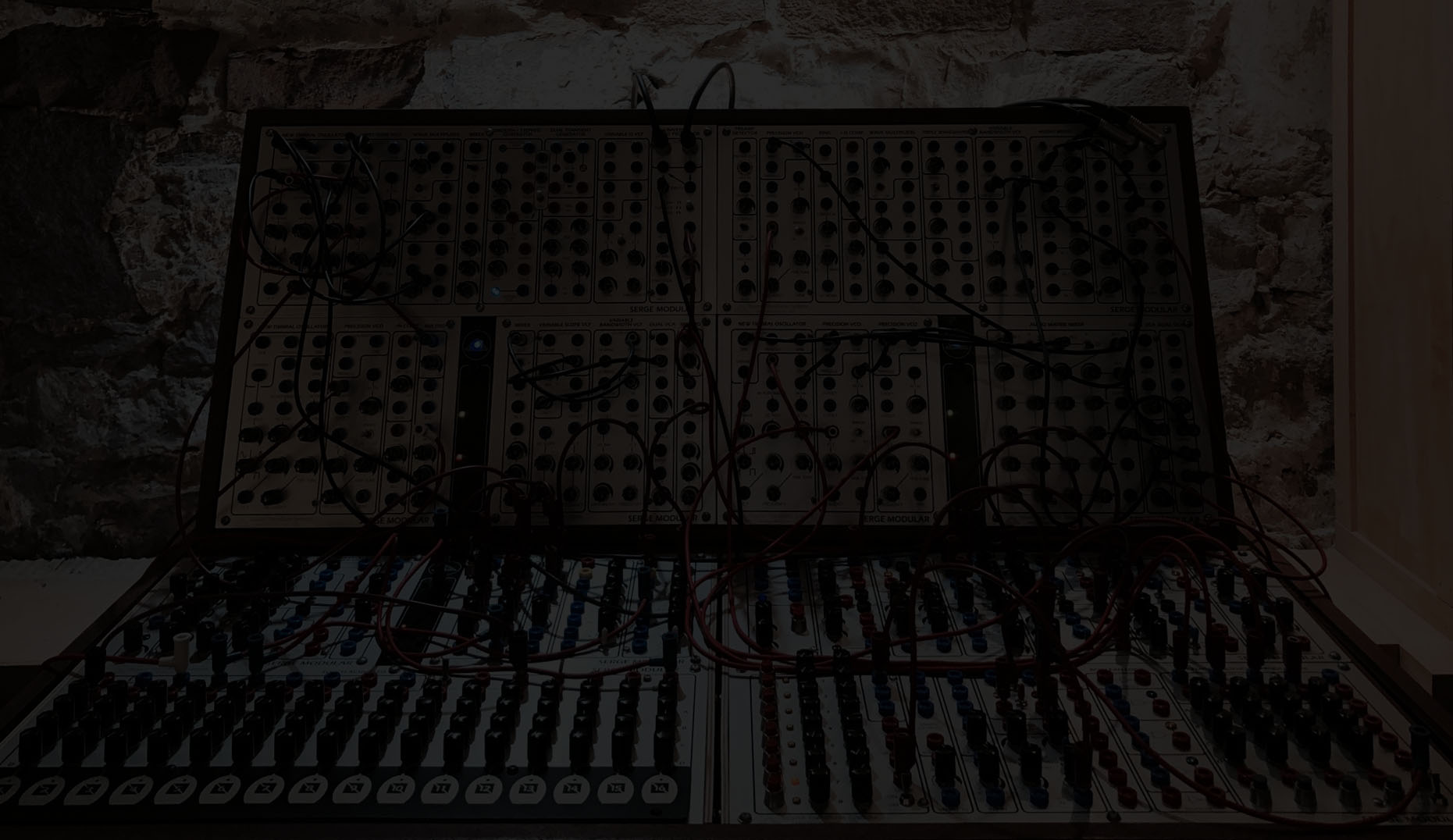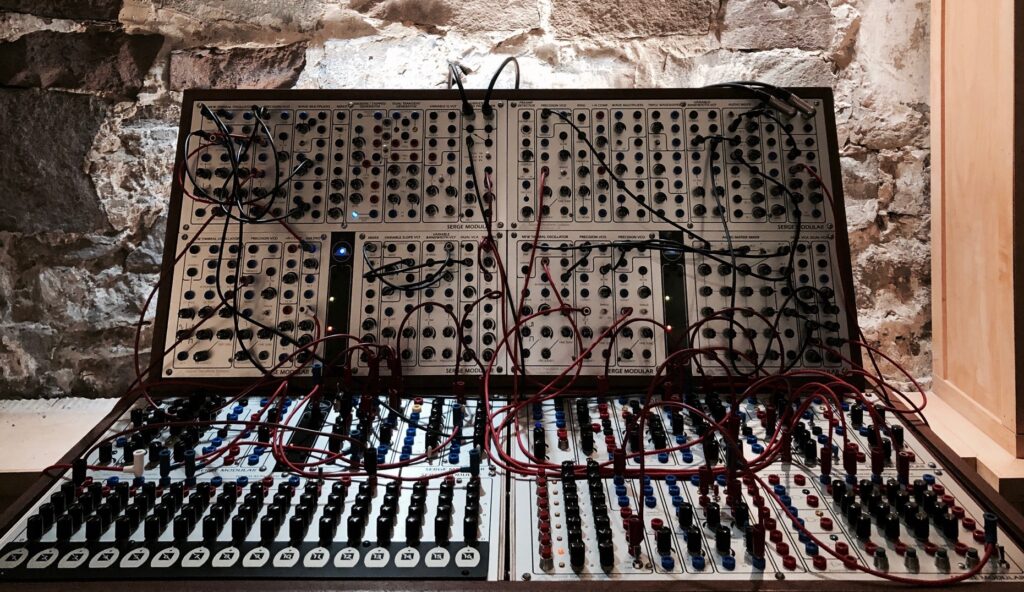
Canadian musician and composer Michael White, plays trumpet and modular synthesizers for film and television. He is busy as a session player, mostly remote these days, for a number of film composers including Andrew Lockington, David Buckley, Jon Goldsmith, Joe Trapanese and Christophe Beck. As a composer, he has scored features, Netflix series, documentaries and radio dramas. His scores and session work rely on his unique approach of blending modular synthesis with acoustic instruments and orchestra.
Some of the highlights of his performance career have been with New Music Concerts series in Toronto, playing trumpet with the NMC ensemble performing music by Cage, Kagel, Berio, Birtwistle, Globokar and Tenney to name only a few. Touring with Bruce Cockburn, David Torn’s “Cloud about Mercury”, club dates in Toronto with Hugh Marsh, Roberto Occhipinti, The Henry’s, King Brand, Claude Ranger and Freddie Stone. He also formed the group “Lonely Universe” with long time friend, drummer Michel Lambert which toured Canada and recorded a self-titled album for the German label CMP.
What have you been working on lately, and do you have any upcoming releases or performances?
Recently (Jan 2021) I finished co-scoring a Canadian thriller called “Trigger Point” with one of my best friends and musical collaborators Andrew Lockington. The film was very inspiring to work on and a lot of fun. We wrote, recorded and mixed the score with COVID protocols so it was a bit different than usual. I missed the in-person effect of finding those “happy accidents” that you can get from bouncing ideas around when you are in the same room. The process online wasn’t bad just different. Since communication and file sharing is so easy these days different “happy accidents” happened like laying up a couple of stems that weren’t intended to go together but turned out to combine really well. These sorts of things give the score life that is hard get working alone in your studio. I am however very excited for the next time we can get musicians together in a room and play! The music turned out really well, which by the way uses a ton of Serge, and we are just now getting ready to release the score on the Movie Score Media label out of Göteborg Sweden. Beyond session work and film scoring I’m spending my time on a full length album of non-film music as well as trying to develop and improve my Modular performance technique in hopes that once this pandemic is done there might be some gigs to play! I really need out of the studio and miss hanging out and live music.
How were you first acquainted to Modular Synthesis? When did that happen and what did you think of it at the time?
It’s kind of funny when you consider my tastes and interests. I think the first time I realized there was a wall of electronics called a Moog Modular was after hearing Keith Emerson’s solo on “Lucky Man”. It was so visceral when I first heard it in the ’70’s the first time. The Moog seems to come out of nowhere and dominate the guitar in a very “organic” way. When those detuned oscillators with portamento swoop up, I still get chills. It’s kind of interesting to me, since I’m not an ELP fan, that the sound and emotion of the Moog connected with me beyond the music. Other than that experience, I am a huge fan of Miles Davis and even though his electric music doesn’t use modulars it did plant the seeds for me wanting to electrify my trumpet with pedals and delays. This has always been a part of my voice and has eventually evolved into using modulars in my music.
When did you buy your first system?
Early 2000 I found the Modcan site online. I really didn’t have any idea what I was going to do with a modular but I had a weird feeling: “I don’t know what I’m going to do with this but I need one of those!”. After a few emails, the maker Bruce Duncan, invited me for a demo of the system. It turned out that his shop was a 10-minute walk from my house! I didn’t know him before I got the system but during that demo we realized I had done some sessions on trumpet for his brother-in-law Ian Blurton and his band Change of Heart. So it all seemed like destiny.
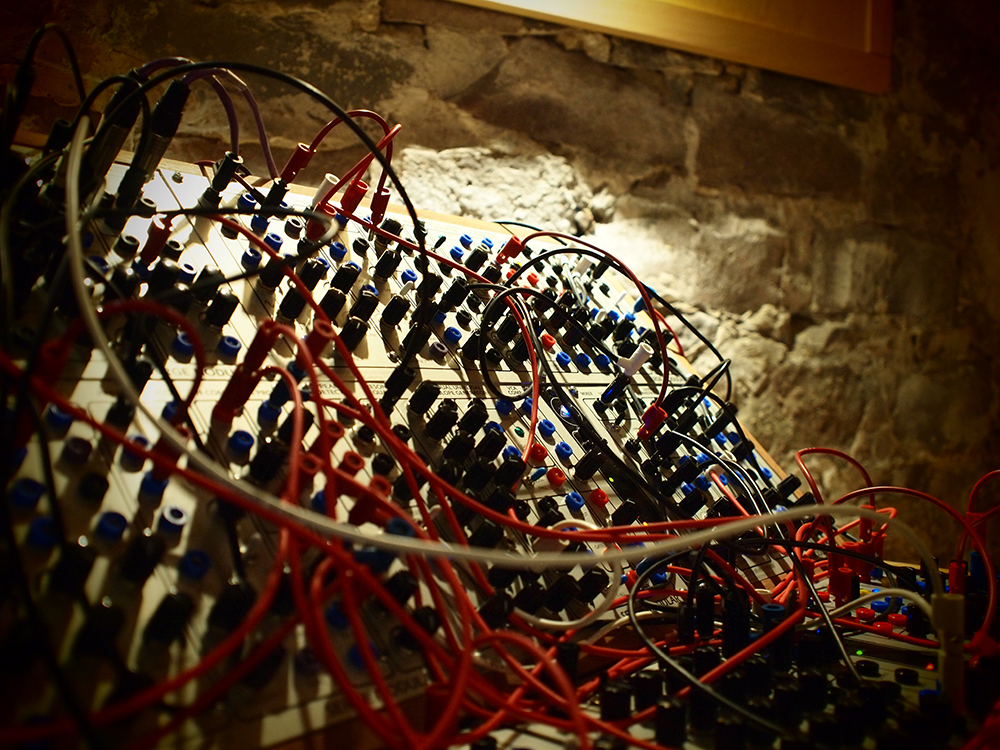
What was your first module or system?
I can’t remember exactly what was in the first case but it was really well put together as a system by Bruce. I think I had 2 oscillators, a dual slope which he calls an LFO, a wave multiplier, a multimode filter, VC envelope and an output VCA panning mixer.
How long did it take for you to become accustomed to patching your own synthesizer together out of its component parts?
I had done a lot of Max programming so patching wasn’t a foreign concept. Although this was before MSP, most of my patches were control type things that I used over midi with my signal processing outboard rig. On the synth I learned to patch basic signal paths pretty quickly. I made some interesting music but I was really using it like it was a glorified mini moog. I hadn’t heard of Serge before I got my Modcan but reading through the Rich Gold book I quickly came to realize the Serge side of things was where I needed to go. When I got my Animoo and TKB from Rex Probe I was hooked and started to be able to imagine some of the different possibilities inherent in patch programability.
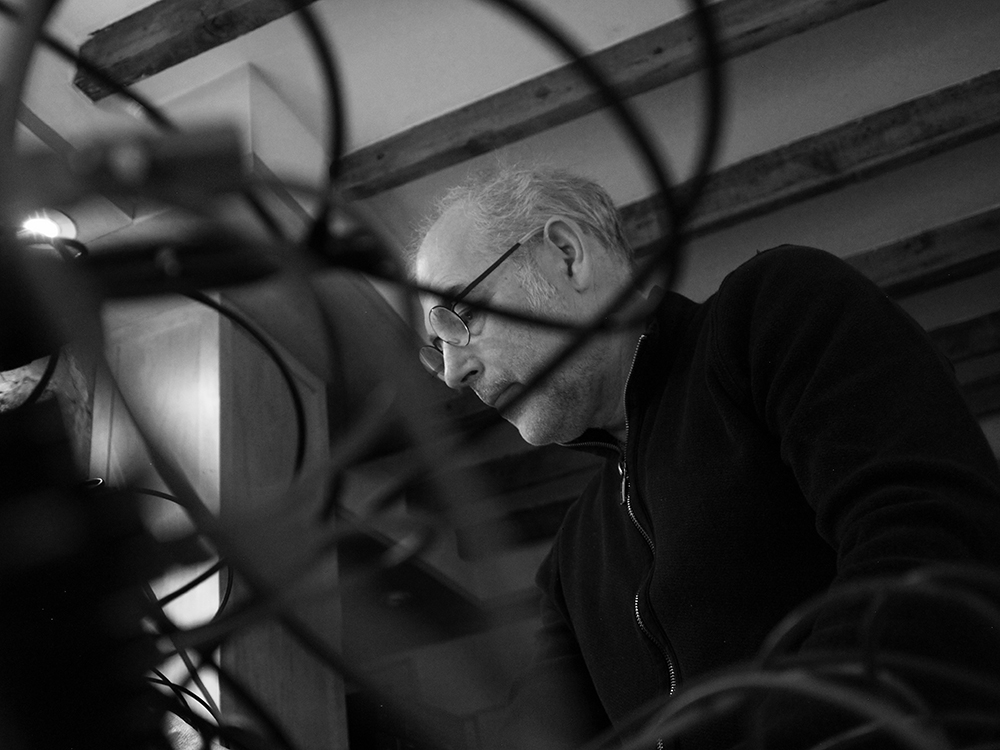
What was the effect of that discovery on your compositional process?
On your existence?
Compositionally I am still scratching the surface. Although I have background that includes a lot of experimental music experience I have always been a player first. Composition for me has always been a loosely structured improvisation. The thing about composing on a Modular that is so inspiring, is you are working within a system to create a situation where the music you imagine comes out or you setup up a system and follow where it goes. Both ways you are defining the system by how you choose to define the instrument. My pieces in this session are all explorations of patch ideas I have been kicking around over the past two months while looking for a new jumping off point. The configuration for the pieces titled “Mirror” is one I’m working with a lot right now. The TKB feeds a sequence and the inversion of that sequence (mirror) to a lot of different places. The sequences are being mixed and transposed and influence the pitch and rhythm in different ways. This type of interaction interests me a lot. Another thing I am working on is finding ways to organize the “loci” of a patch as Rex Probe calls them, or points of control, grouping them to areas that then can easily be used to influence multiple parameters dynamically in real time performance. These pieces are just me trying to find different musical uses of the parameters that are defined in each of the starting point of these patches.
Quite often modularists are in need for more, their hunger for new modules is never satisfied? How do you explain that?
When thoughts of “I need more” start creeping into my head I try to remind myself that it’s not what an instrument does, it’s what you do with an instrument. We live at a time where over-consumption is a norm, which is a huge problem. We have been programmed by our culture to want the newest thing and if we don’t have we are somehow missing out. I understand artists who are looking for something and feel the need for a different or new set of instruments to accomplish their vision. It is natural. How many professional guitarists have just one guitar? I’m embarrassed to say I have 20 trumpets and about 40 mouthpieces. I can’t bring myself to sell any of them. For me what I look for in a musical instrument is to be able to have a personal and emotional connection with it, as strange as that sounds to some people. I’ve settled on my Serge as one of those instruments I connect with because I feel an emotional attachment to it. To be clear I mean a connection with the specific one I have! The truly amazing thing about the Serge System is its’ ability to be reimagined every time you play it. Once you have the one you connect with, you really don’t need that much more.
Instrument building may actually be quite compositional, defining your sonic palette, each new module enriching your vocabulary. Would you say that their choice and the way you build your systems can be an integral part of your compositional process? Or is this the other way round and you go after a new module because you want to be able to sound-design some of your ideas?
Do you prefer single-maker systems (for example, Buchla, Make Noise, Erica Synths, Roland, etc) or making your own modular synthesizer out of individual components form whatever manufacturer that match your needs.
I do have other systems than my Serge but never feel like mixing them together. Just my preference. I think working within limitations is heathy and essential for me. Fortunately, I don’t see Serge as a “limited” system, just the opposite, it’s infinite. We have so many distractions these days. I really don’t want to spend time thinking about what if I had this or that. I want to spend time making music. But… if the opportunity ever came up for me to be able to play a Buchla 100, Buchla 200, Arp 2500, Moog 55 or a Synthi AKS I would grab my portable recorder hop on a plane and geek out for sure!
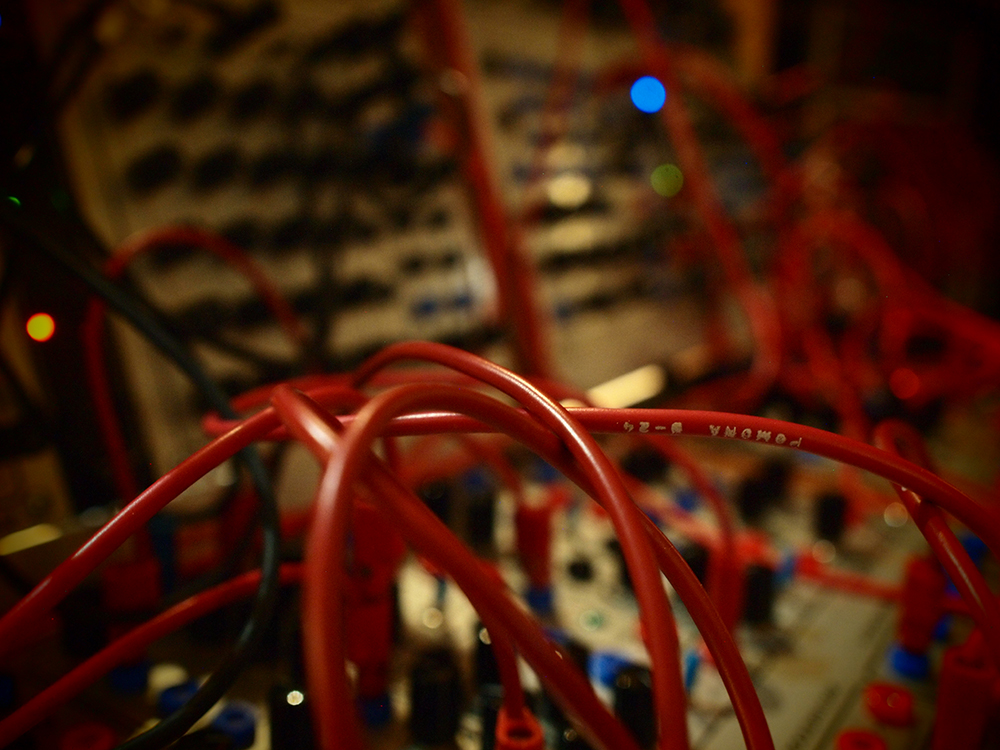
How has your system been evolving?
It is evolving in my mind really. I keep saying this but patch programability is what makes this happen. The system is so flexible and adaptable to different configurations it seems like infinity in a box at times. What is evolving is my ability to find new ways to play it. Talking with friends and working out ways to patch specific musical gestures or ideas alway seems to give me a new insight into something I had never thought about. It’s so cool. Rex has been a true mentor for me in this sense. Every time we talk whether it’s about music or not something emerges that gets me thinking. He is very generous with his time. As far as adding panels to what I have now, Rex and Kevin Braheny Fortune are building me a STS CV-1 panel with some great mods to help me with live performance and some of my compositional ideas. Maybe I will add another TKB at some point but for the way I work I really need to keep my Serge to instrument size not orchestra size, if that makes sense.
Do you tend to use pure modular systems, or do you bring in outside effect and devices when playing or recording?
I like using out board processing as I record. Delays, spring reverbs, guitar pedals etc.. I have a basic set that I haven’t changed for a few years. I have a patch bay on my pedal board that allows me to reorder the devices and using them with other eq’s compressors and my go to “Overstayer Modular Channel” I seem to be able to find things that interest me. I always record them to their own set of tracks. I do this because I like to play the knobs and change parameters on the outboard gear as I go. I can always re-record or rebalance anything that isn’t working. I have always done this because when working on a movie for other composers contexts change and you don’t want to bake a huge reverb into a sound incase it needs to change. It is sometimes impossible to recreate a part or sequence so you need to track as many discrete elements as possible in these situations.
Would you please describe the system you used to create the music for us?
My Serge is 8 panels and was put together at STS by Rex Probe. It is a combination of shop panels and m-class. There are 8 oscillators, 1 quadrature oscillator, 2 wave multipliers, triple wave shaper, 2 ring modulators, 3 DSG’s, 4 DTG’s, 2 SSG’s, Variable Q VCF, 2 Variable Bandpass VCF’s, Variable slope VCF, random source, audio mixers including a matrix mixer, CV processing, logic: boolean, 2 ÷N com, 4 comparators, ASR, TKB, 8X2 sequencer, 4X4 programmer, 6 audio VCA’s, Dual Stereo Mixer and a UAP. It’s almost impossible to list the functionality of the system because so many of the modules can be configured to do multiple things. I would strongly encourage anyone interested in Serge Modular to read the Rich Gold book, “An Introduction to the Serge Modular Music System”.
Can you outline how you patched and performed your Modulisme session?
I think there are 4 different patches in this set of pieces. It’s kind of hard to describe them without doing diagrams but I do have some go-to starting points. I like to use the matrix mixer as a place to route and feedback most of the audio paths. There are 4 vca’s beside it so it becomes one of the timbral “loci” for a lot of my patches. Usually there is at least one CV processor for combining the envelopes, dynamics and tremolo and another one for pitch. I usually use a fast master-clock or sync a “main” clock divider to the computer I am recording to if I am going to do overdubs. The master-clock drives a number of dividers that get modulated for rhythmic functions, that I control by hand or a sequencer. Generally the programmer is used for transpositions or moving groups of signals together. The TKB and the 8X2 sequencer do various things in the pitch and time domain and combine together to create longer gestures with the TKB. I use logic functions to interrupt or turn on and off different events. Last but not least, and the key, are the DSG’s which I am always patching to do what ever is needed. Of course none of this is static, everything evolves and changes in response to what the music is doing at any given moment.
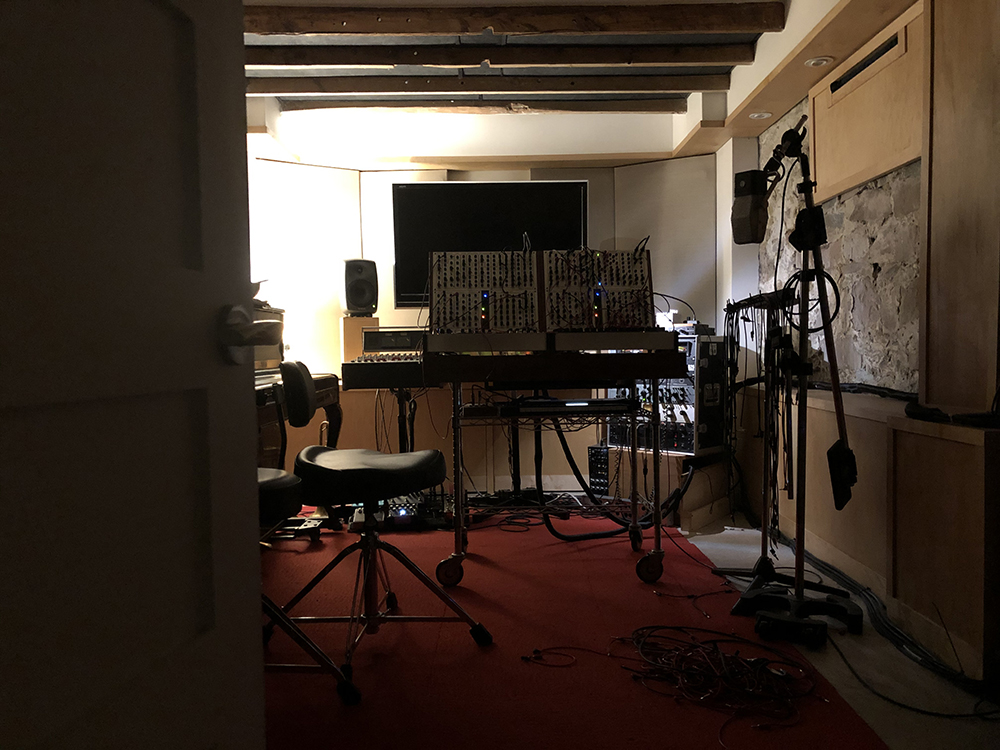
What do you think that can only be achieved by modular synthesis that other forms of electronic music cannot or makes harder to do?
I think that might be up to the person creating the music. For me a modular synth is an instrument that can react to the player more like an acoustic instrument than a modern keyboard synth, sampler or computer. You can push and pull it in ways computers really can’t do due to their digital nature. An example is comparing digital control (stepped) and analog control (which is almost always non-stepped or continuous in synthesizers). An analog potentiometer has only 2 defined positions: all the way on and all the way off. All the stopping points and in-between interactions you get are all arbitrary, never exactly the same twice. That’s where the magic is.
What would be the system you are dreaming of?
Fortunately for me I have it at the moment. When I think of something I haven’t done before I almost immediately visualize a few things to try on the Serge. It is slowly becoming second nature to me. Love that!
Are you feeling close to some other contemporary Modularists?
Modular Station has exposed me to a ton of artists I had never heard of. I really feel close to all them including the ones whose music is completely different than mine. The fact that we are all making music using modular instruments and coming up with all these different approaches and music is very inspiring. The Serge-0-Vox and Buchlaïsms collections on Modulisme are amazing examples of the diversity of approaches.
Which ones?
Every time I listen to Modular Station I hear another artist I want to check out more in depth. Through Modulisme and Modular Station I have met a number of artists that I have connected with via the internet and really enjoy sharing ideas with. So the list is long. Thinking about it I’d say I feel close to everyone making music on a modular because it’s not the simple way to do things. It takes time, thought and preparation even when you are improvising. I admire everyone who puts music ahead of the ease of use whether is computer based or analog hardware. Most people don’t get it, including musicians. They say things like: “You spent how much on that Synth? My car cost less!” Basically they answer their own question.
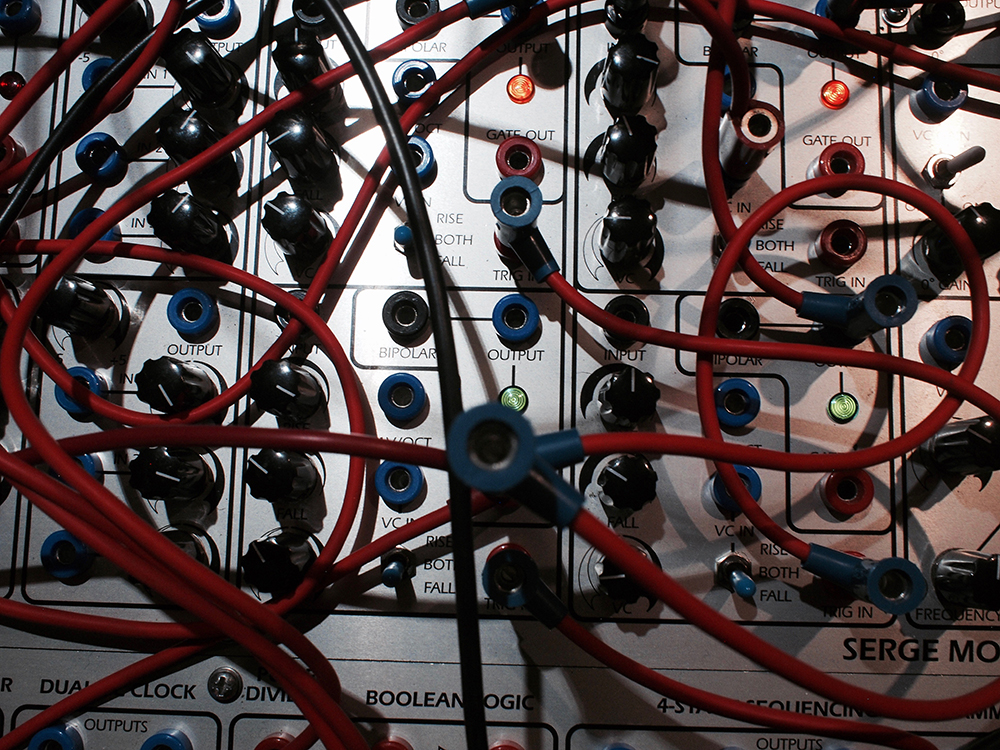
Which pioneers in Modularism influenced you and why?
I studied music at the University of Toronto which had a very innovative electronic music studio that Hugh LaCain setup in the early ’60’s. He was responsible for some amazing equipment. His tape piece “Dripsody” was created from the recording of one drip of water. When we studied electronic music history the professor was all about the Canadian guy! “Dripsody” introduced me to Musique Concrète before we were exposed to Pierre Schaeffer. Haha. Kind of strange. Ligeti is a huge influence musically for me even though he didn’t do very much electronic music. His organic sense of gesture, harmony and rhythm are amazing. Some of the pre modular artists using electronics that have influenced the way I think about music would be Cage, Tudor, Takemitsu, Xenakis, Berio, Stockhausen to name only a few. All of them pushed the idea of what music could be, inspired me to try and be open to all musical expression. As far as artists who played modular instruments, Subotnick, Eno, Cortini and Jon Hassell are some off the top of my head but there are many more. The composers who worked at Ircam such as Gérard Grisey and Tristan Murail and GRM composers such as Beatriz Ferreyra and Bernard Parmegiani have also opened my mind and ears to thinking about different compositional structures that I need to explore. Recently I have been mesmerized by the music of Eliane Radigue, whose music Philippe Petit introduced me to, she is able to suspend time in such an effortless way. Love it.
Any advice you could share for those willing to start or develop their “Modulisme”?
Try not to get caught up in “If only I had more gear”, I could do the music I want to do. Use what you have or can get ahold of and find a way to make something you feel is musical. If you are buying individual modules one at a time, try to envision an instrument or system not just a collection. As you make more and more music, it will become apparent what you need to realize your ideas. You can waste a lot of time and money buying shit you don’t need. I think having a mentor or person you can bounce ideas off of and critique tracks with is really important in developing a voice of your own.
I’d like to thank Modulisme for this opportunity to share some of my music and experiences. Also I’d like to say that I love the “Sessions” and Modular Station. I find new and amazing music each time I listen.
Thanks to Philippe Petit and the Modular Station team. Bravo!
